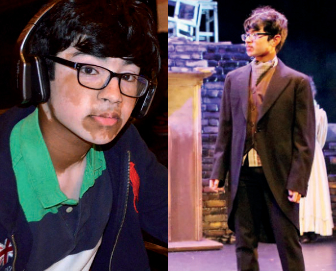
Other conditions
There are a huge range of skin conditions and we have covered more of the more common ones below. If you don’t see one that you would like us to share more information on, then please get in touch and we can add it to this page.
Overview
There are literally thousands of skin conditions that can affect children and young people. Here is some information on some of the more common ones and resources for where to get more information.
For some more general information visit:
- DermNet New Zealand: A free dermatology resource with reliable information on almost every known skin condition
- BAD patient information leaflets: Information on skin conditions from the British Association of Dermatology and BSPAD
Genital Skin
Genitals are as unique as you and there is no one way or size they should be. Genitals change through puberty and the timing of this is different for different people
There are many normal skin changes of genitals. Skin conditions such as eczema, psoriasis and HS can affect the genital skin and it is important to talk about this and get management for these areas.
Lichen sclerosus is a not uncommon skin condition that can affect genitals and cause skin changes and itch.
If you are sexually active, practice safe sex and take steps to ensure you don’t become a parent sooner than you plan to and get screened regularly for STIs.
Hidradenitis suppurativa
Hidradenitis suppurativa – sometimes just abbreviated to HS – involves inflammation of glands in the skin. These glands are called apocrine glands, and most of them are found in the armpits, groin and breasts. For reasons we don’t fully understand, in HS these glands behave abnormally; they are more prone to becoming blocked and inflamed, which can cause skin problems similar to those seen in acne such as blackheads and boils.
HS is a common condition that affects between 0.4-4% of the population in UK, and is most likely to develop in young adults. The numbers might even be higher than that, as we know that many people are not correctly diagnosed or do not seek appropriate help. It is a chronic condition, by which we mean it is a long-term thing that gets better and worse over time, and flare-ups can be very painful. The persistent inflammation may cause connections to form between affected areas, and lead to scarring of the skin.
HS is not caused by one thing but a combination of genetics and environment. Smoking and being overweight can be part of the cause for some people but it can also happen if you are a normal weight and do not smoke.
If you do have HS, trying to keep a healthy weight and steering clear of cigarettes are important, positive things that you can do. Avoiding tight clothes, which may increase friction to the skin, can be helpful too. There is also some evidence that laser pubic hair removal might be better than shaving or waxing the pubic area, but this is unfortunately not something everyone can afford.
Although there is no cure for HS, there are plenty of treatments that can be offered on top of the suggestions above. In the earlier stages of HS these will usually be options such as gels and tablets, whereas more longstanding and severe HS could benefit from operations. There is no cure for HS, but treatments such as these can be very effective in both preventing and treating flare-ups. They can’t switch off HS once and for all, but it may become inactive eventually.
Hidradenitis suppurativa - useful links and resources
Hyperhidrosis / Sweating
Hyperhidrosis is just a fancy word for extra sweating or perspiration. We all sweat to some degree – unless we have hypohidrosis, the opposite condition in which little-to-no sweat is produced – but when it happens too much, or in the wrong place and at the wrong time, then it can become a problem.
Sweat is produced by glands in the skin called eccrine glands, with the aim of keeping us cool when we get too hot or have started to exercise. For people with hyperhidrosis however, an inappropriate amount of sweat can be produced, often at times when it’s not necessary. This can happen in various different body parts, and the issues it causes therefore vary. Having very sweaty hands might make it difficult to write, or nerve-wracking to shake hands with people, whereas lots of sweat on clothing can affect a person’s confidence and the clothes they choose to wear. Either way, this can have a huge impact on the way people feel and behave.
A bit of sweating is normal but being drenched in sweat and leaving puddles is not. If you’re worried or frustrated then speak to your doctor, or have a look at www.hyperhidrosis.org for more useful tips.
Hyperhidrosis - useful links and resources
Infections
Healthy skin is host to millions of different bugs (viral, fungi, yeasts, bacteria, parasites) most of which are harmless and a normal part of our flora.
Sometimes bugs can cause problems including pustules, boils, hair-loss, changes to pigment and flaky, itchy skin. Certain skin conditions and if your immune system is not working properly for whatever reason can make problem skin infections more likely.
It is important to diagnose skin infections correctly so you can get the right treatment and not pass on these infections.
Urticaria / Hives
Urticaria is the medical name for hives, which are also known as either wheals or ‘nettle rash’. These are itchy marks that appear suddenly on the skin, with a well-defined red edge and pale, swollen area at the centre. Sometimes swelling of lips, eyes and other areas of skin can be seen with urticaria – Angioedema. They are caused by release of certain substances into the skin including histamine. The main treatments are anti-histamines which can be taken both to manage and prevent urticaria depending on the type and cause.
Urticaria and angioedema can be caused by allergy (food or medicines) and in these cases the rash and swelling happen very quickly in response to allergens, usually within minutes, and this can be very scary and needs urgent treatment and investigations into possible allergic causes. An adrenaline pen may be prescribed in case of accidental exposure and if needed this should be carried at all times as can be life saving.
The most common cause of urticaria is spontaneous urticaria. In this condition the hives can come and go at any point in the day or night and are not related to any clear trigger.
Urticaria can also be caused by physical triggers such as pressure or less commonly sun or water. Cholinergic inducible urticaria (CIndU). Cholinergic urticaria is a form of physical urticaria which is quite common in young people and can be triggered by sweat, heat, hot showers, emotional stress and spicy food. It causes very small hives to appear within minutes, usually on the upper part of the body, although they can be widespread. The rash generally lasts for less than one hour, but – especially if it seems to be triggered by emotional situations – can feel embarrassing.
As they are not triggered by an allergen, no allergy tests are needed for spontaneous or physical urticarias; unlike allergens however, it is difficult to avoid triggers like emotion and heat. Fortunately, this type of urticaria normally responds well to antihistamine treatments, especially before a known triggering event such as exercise.
British Association of Dermatologists - information on systemic medications
Pranav's story about vitiligo
Pranav is 13, and he’s always busy with lots of
interests. He likes K-pop, and he plays the drums. Hockey is his favourite sport, and he likes writing too, creating futuristic stories set in fantasy worlds. Recently he’s enjoyed acting in school plays ‘But when I grow up, I’d like to be an architect,’ muses Pranav, ‘or perhaps a game-designer.’
Pranav’s vitiligo started when he was about four years old. When he was little, he says, no one bothered about it at school. But now that he’s getting older, he’s aware of people staring when he goes out. ‘My friends don’t care,’ he says, ‘and we don’t talk about it much. When people are familiar with it, it’s less of an issue.’ But sometimes now it can feel like an effort to go out somewhere new.
Pranav has had some difficult times particularly when they have been to India to visit relatives. ‘It’s a different culture over there,’ says his mum, Veni. ‘People ask very direct questions, and they offer advice. It got very repetitive, and Pranav wasn’t very happy. So now we go on holiday in Europe or the States, where we haven’t had these problems.’
Teachers at Pranav’s school have been understanding and supportive. They put Pranav in touch with an older boy at his school who also has vitiligo. Together they’ve discussed the pros and cons of using camouflage to cover the lighter patches. ‘Camouflage is not for me,’ says Pranav. ‘Everyone knows that I have vitiligo,’ he says, ‘so there’s no point in hiding it. It would come out anyway.’
He was also offered the chance to talk to a counsellor at school. ‘But I didn’t want to miss break-time with my friends,’ Pranav grins.
What is Pranav’s advice for living with vitiligo? ‘Don’t feel you should only stay at home. If someone stares, it’s just for a couple of seconds, and then they’re gone. You hope they’ll think about it afterwards. ‘And vitiligo can help you too,’ he adds. ‘If people judge you because you’ve got vitiligo, then they’re not a true friend. So vitiligo helps you know who your real friends are.’
Story provided via the Birmingham Women’s and Children’s NHS Foundation trust.
Get in touch


